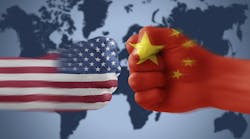Why the US Government Needs to Be Engaged in Economic Development
One of my recent columns (“How Best to Get Government Involved in your Business”) generated a response from reader “Toppers” who posed several thoughtful questions concerning government involvement in economic development. No one wants government involved in their business per se and economic development doesn’t necessary imply such involvement. From my perspective government economic development is needed primarily when other outside factors—usually foreign governments—act in such a way that the playing field is no longer level for U.S. manufacturers.
“Toppers” posed specific questions which I will attempt to address in my next column. First, though, I feel the need to give some context for how my views have been shaped on this subject. Specifically, they were formed when managing a purchasing group during the emergence of China as an industrial power.
I started in purchasing as a procurement engineer (technical buyer) for a major U.S.-based original equipment manufacturer (OEM) in the late 1980s. Included in my responsibilities was source selection. Later, by the mid-1990s, I was a mid-level manager over procurement engineers with overall annual sourcing responsibility for several hundred millions of dollars. This was at a time when China was rising as an industrial power and it did so with a vengeance that had never been seen before and may never be seen again. It seemed that almost all-at-once manufacturer reps for Chinese firms were approaching U.S.-based OEMs with proposals 25% or so lower than current pricing.
This might seem like a panacea for someone in my position since purchasing performance metrics are primarily based on year-to-year price reductions, and it might have been, if price was all I was concerned about. The fact was, however, that I didn’t feel comfortable sourcing without doing some level of due diligence relative to the overall track record and capability of any new potential source, Chinese or not.
Part of this due diligence would be to understand how Chinese manufacturers could undercut our current suppliers by such large margins. In particular, my interest was sparked by one proposal from a Chinese manufacturer for a part I had once personally sourced. In fact, the U.S.-based supplier I had sourced the part to had recently taken advantage of supplier development assistance from my company and based on that support had developed into what we thought was a world-class manufacturer.
I will use this part and supplier to illustrate a point, but before getting into the details, first let me say that people seem to have gotten the impression that Chinese manufacturers compete solely based on low wages and little or no regulatory oversight. It is true that Chinese companies spend significantly less on wages and little or nothing on mediating the negative toxic effects manufacturing processes can have on the environment. In fact, uninformed (and usually self-appointed) manufacturing wonks have admiringly labelled China the Wild West of Capitalism, going on to say that the Chinese manufacturing environment represents “free markets in action.” In reality nothing could be further from the truth. Let me show this using the previous example.
The design of the part in question was fairly basic except that it required high tensile steel. The part’s manufacturing was also fairly basic except that it required annealing to remove processing-induced stress concentrations. This is because the part—a cutter—rotated at high speeds and could fracture upon impact if not ductile. A catastrophic failure such as this has the potential to cause injury or death to people either operating or near the equipment, and needed to be avoided at all costs.
An important point I need to make here is that while the Chinese quote came in about 25% less than what we were currently paying, the raw steel portion of the cost-of-goods-sold amounted to over 50% of that price. Assuming that steel is a worldwide commodity—meaning that our current supplier and the Chinese alternative had to pay the same amount for their material—this meant that the Chinese manufacturer was actually quoting a cost structure 50% lower than those aspects of the cost that our current source had control over. This seemed too good to be true (especially in light of our recent successful supplier development effort) and so really caught my attention. Where could the 25% advantage be coming from?
Getting down to the “nitty gritty” of the Chinese quote, their advantage in labor over our current source amounted to only 5% of the price we were paying. You may wonder why this advantage was so low given the difference in wages between China and the U.S. It was because the supplier development project had minimized the incumbent supplier’s labor content. In fact, most people don’t understand that only about 10% of U.S. manufacturing cost-of-goods-sold is comprised of labor. So where was the 25% coming from?
The stress relief process involves heat treating the finished product in a salt bath. After this, the solution is highly toxic and there are costs involved in treating it. The cost involved here, however, amounted to only 3% or so of the total price we were currently paying since the incumbent manufacturer very efficiently treated their waste. Even assuming that the Chinese manufacturer wasn’t saddled with any toxic waste mediation responsibility, this still left them with only an 8% advantage—still far short of the 25% difference in their quote. Further due diligence was needed.
How about profit? Were the Chinese undercutting profit margin compared to our current supplier? I never was able to figure out an apples-to-apples profitability comparison but I considered it a wash. How could I justify this assumption? Did you know that in China a high percentage of manufacturing ownership involves the government and/or its military? Because of this, the key to being successful in business there is most often not just what you know or what you can do but “who you know.” I don’t think governmental or military ownership is a paradigm that supports forgoing profit. And I guess I was right since today there are more millionaires in China than there are in the U.S. That doesn’t sound like a result of the Chinese undercutting profits to buy-the-business, does it? So again, the question was,“Where was the 25% advantage coming from?”
Unraveling the Mystery
It is widely known that the Chinese government artificially undervalued its currency during their manufacturing emergence (and still does, although last summer they allowed it to “float” a bit) and I took this into account. This means that our dollars went a lot further in China than in the U.S. Currency fixing can only happen in an oligarchy (which is what the Chinese Communist Party represents) since it is certainly not to the advantage of the common person to be paid in an undervalued currency. But who was I to tell the Chinese government how to treat its people? I figured the undervalued currency gave them about a 7% advantage in quoting, to a composite advantage of about 15%. Still haven’t gotten to 25%, though, have we?
In looking at the proposal I found out that the Chinese manufacturer was buying their raw steel from a government-owned steel company. Under severe “interrogation” the manufacturer rep admitted that the government had discounted the steel price on this specific job since a) it involved a specification they normally didn’t produce, and b) they wanted to use this job as an entry for developing a competency in its production. I was never able to pry the amount of the discount out of him but I estimated it at 5%. This gets us up to about a 20% price advantage—not 25%, but getting closer. But realize that 60% of that accumulated 20% was due to Chinese government intervention, not competitiveness.
The final piece of my due diligence completed the answer. Unnoticed by the manufacturer rep, I had one of our Chinese-sited factories (my company also manufactured in China) submit a request-for-quote for the exact same part—the original quote having been for a U.S.-sited plant. The Chinese quote to our in-country location was 15% higher than what they quoted to our U.S. plant. Again, through further “interrogation,” the manufacturer rep admitted that the Chinese government was giving the firm an export credit for any product sold outside of China. So now, we’re up to a 35% percent advantage over the U.S. source. But of that only 8% was “real” with the rest the result of Chinese government intervention. Hmm. Wild West of Capitalism, my a**!
I’m not sure if this type of Chinese government involvement extended beyond this single example but I’d suspect it did. Unfortunately, someone in my position can’t take the time to do this type of due diligence on very many proposals. And no one would really care about what I found, anyway. After all, why would anyone working in an OEM purchasing function care why they were getting lower priced parts? Those lower purchased piece prices promoted OEM profitability, at least in the short run. And since “everyone was doing it,” electing not to source in China would have yielded an advantage to the competition.
In this case I made the decision to keep the business with my current U.S. source. I’m glad I did as we had a true partnership with that supplier that yielded year-after-year improvements to my material variance metric! In addition, I also didn’t want to risk sourcing such a function- and safety-critical part with such a relatively untested company. And, in the end, it just pissed me off what I had found in my due diligence about Chinese government intervention. I guess my kindergarten teacher Mrs. Pfost at Van Buren School in Cedar Rapids, Iowa, had it right when she wrote on my report card: “Paul has a decided sense of what is right and wrong. He is more than willing to do his share for a cause if he believes he is right.”
However, be aware that during this period I also did a fair share of resourcing from incumbent U.S. sources to Chinese manufacturers. I—and most people in my position—really had no choice.
In the 1990s and the early 2000s the U.S. had a lot of small and medium-sized manufacturers go broke because they couldn’t compete with Chinese suppliers, including many suppliers to my company. I felt partly responsible for this and knew that the bulk of the non-competitiveness wasn’t real. It turns out that our U.S. suppliers were competing not only with individual Chinese firms but also the Chinese government. Let’s be realistic, China couldn’t have had the progress it’s made in manufacturing over the short time period it did without significant government involvement. No way.
I don’t blame the Chinese for adopting this strategy but I will point out that the type of government control they exerted is not possible in a democracy. And it’s not just the Chinese. Most leading manufacturing countries have some sort of government involvement in manufacturing, although it is usually handled more subtly. For instance, do you really think that the Koreans could launch a whole new automotive industry over a period of 20 years and get to where they are today without extensive government involvement? The numbers just don’t add up. And, by the way, who is their largest market? The good ol’ U.S.A. Hmm.
So what is a purchasing manager to do? I knew that others in my position were seeing the same things but no one—understandably—was talking publicly about it. I started looking around and saw that there were very few governmental resources U.S. manufacturers could call on. One is the Export-Import Bank. Another is the Manufacturing Extension Partnership (MEP). Because of what I had experienced—and feeling the need to atone a bit—I began a 20-year relationship of support for MEP. And, to be real, our governmental resources provide nowhere near the level of governmental support I saw coming from “low piece-price” companies during my tenure in purchasing management. And, over that same 20 years, I witnessed time and time again attacks on the Export-Import Bank and the MEP System where uber Free Marketeers tried to eliminate and/or defund them.
So now you know where I’ll be coming from in my follow-up article on governmental economic development. I hope this article will generate replies with similar examples to what I have outlined from other purchasing people. As a society we’ve had 20 years where U.S consumers have gotten low-cost appliances, electronics, etc., and now China is building their first nuclear aircraft carrier. Go figure. Should we be surprised? Is this really what is best for the United States or should our government have become more active in supporting our small and medium-sized manufacturers during this period?
What else have the Chinese gotten? Various organizations issue periodic maps of the world’s most highly toxic industrial sites. Up through the late 1980s the vast majority of them were in Communist Eastern Europe. Now, over 80% of them show up on the eastern coast of Communist China. Maybe the Wild West of Capitalism description has some validity to it. After all, I don’t think that anyone can present a serious argument that without sensible regulation bad things tend to happen. I have this ongoing nightmare that over the next 30 years or so the Chinese people are going to develop the mindset that they polluted their country so people in the U.S could have cheap TV sets. How do you think they’re going to feel about us then? I don’t suspect we’ll be singing “kumbaya” together.
The next column will discuss the boundaries of governmental economic development that I feel fit within the context of our society and culture and would effectively level that world-wide playing field our manufacturers are trying to compete on.





